Home ·
Charts and PDF Star-Masks ·
How the Charts were Made
Pearls on Velvet
Star Charts as pretty to Touch as to See
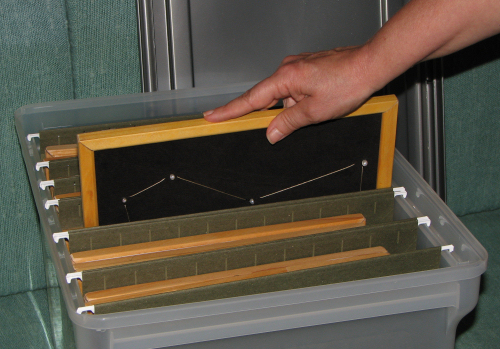
'Star charts should be full-size! That means 8½ X 11", each constellation with
its own wooden frame, and filed nicely in a portable box. If the charts are nice to touch,
all the better.'
And how did we reach this conclusion? Join us on this adventure, and we will give you the
tools to put families of stars into your hands.
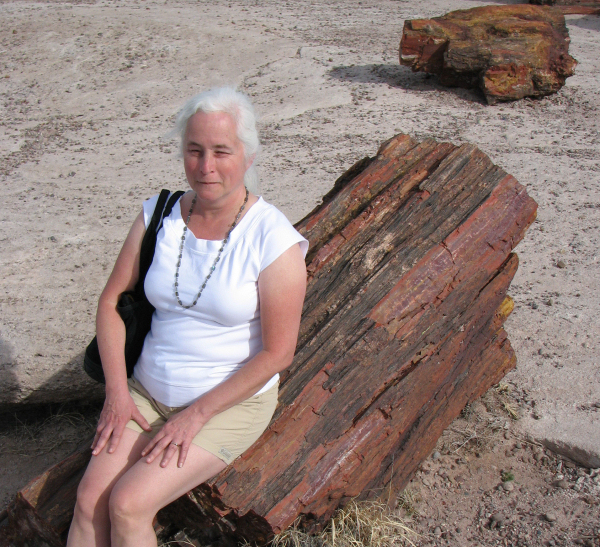
Meet Robbie, posing here with her favorite rock, a log at the Petrified Forest. She
accompanied her husband to a Scout leader training several years ago, and listened in
as the students talked about the stars and planets they gazed at.
Robbie asked "What do the stars look like?" There followed a profound silence. Mark
(Robbie's husband) answered,
"A whole lot of points of light in the sky in a pattern." Said Bill, "The points of light remind us of
needlepoints." Sam added, "They are different colors, some blue, some red, some white."
"They are really very far apart, right?" Robbie observed. "Yes, and yet, because of the way
we see them, we see the patterns of the constellations.", Mark finished.
Robbie asked Mark if he could make a couple of star charts so that she could at
least understand the patterns of some favorites. Remember, poems and other literature make
much commentary about the stars. Robbie loved some of the constellations already, such as
Orion, Pegasus and the Summer Triangle. They soon realized that to really do the job up
right, Mark must make a full set of star charts, at least, of constellations seen from the
northern hemisphere.
Later, they added the Winter Hexagon and the Circumpolar constellations.
"Like hot needlepoints poking out of a very cold background" and such descriptions are
scientific, but do not explain why the night-sky
is nice to see. Poetic license is necessary here, and Mark thought of jewels on a dark
cloth, and eventually, pearls on velvet.
Mark thought it only fair that his wife should enjoy the skies as
much as he did. He visited websites (several listed below), and read about the magnitude
of stars shown by the size of dot. Robbie pointed out that a good tactile illustration is
big enough so that the details do not run into each other.
Links RE tactile charts
We take this moment to thank the people mentioned in the above websites, and many others,
for their hours and years spent developing the craft of tactile illustration. Their work and
their sharing put this project within reach.
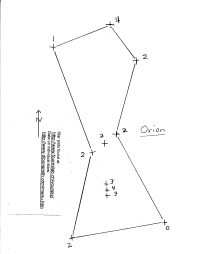
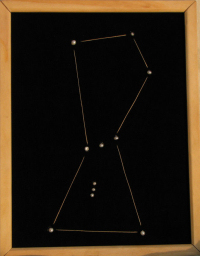
We knew what to do:
Plot the constellations, each on a scale to fit an 8½ X 11" frame. Look up the magnitudes
and write them in. Draw in the outlines. These are the masks.
Create charts, using the masks to place the stars with crosshair accuracy.
For your enjoyment:
We invite you, our visitor, to print out some star-masks (PDF pages), and make some charts,
using your
own materials and your own ingenuity!
Acknowledgments & Links
- Thanks to Bill and Jan Lewis, for supplying pearls and materials to make the charts.
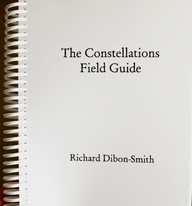 Thanks to Richard
Dibon-Smith, and his wife, Marie-Madeleine for their advice, and for permission to
use star-data from Richard's website.
All of those nifty details are available in a
book.
Thanks to Richard
Dibon-Smith, and his wife, Marie-Madeleine for their advice, and for permission to
use star-data from Richard's website.
All of those nifty details are available in a
book.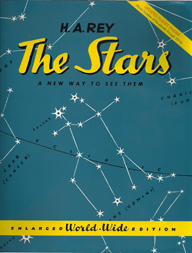
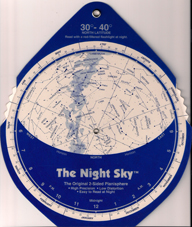 The constellation outlines were composed with use of David Chandler's "Night Sky" planisphere,
H.A.Rey's "The Stars", and the Your Sky
online planetarium.
The constellation outlines were composed with use of David Chandler's "Night Sky" planisphere,
H.A.Rey's "The Stars", and the Your Sky
online planetarium. - The Your Sky planetarium was perfect for star-plots,
from which the constellation masks were made.
- Special thanks to several Scout leaders who looked at a night sky and explained what
a star looks like to someone who had never seen them.
Thanks for traveling with us! Come back again.
Copyright © Mark Wanamaker All rights reserved.
 Thanks to Richard
Dibon-Smith, and his wife, Marie-Madeleine for their advice, and for permission to
use star-data from Richard's website.
All of those nifty details are available in a
book.
Thanks to Richard
Dibon-Smith, and his wife, Marie-Madeleine for their advice, and for permission to
use star-data from Richard's website.
All of those nifty details are available in a
book.
 The constellation outlines were composed with use of David Chandler's "Night Sky" planisphere,
H.A.Rey's "The Stars", and the Your Sky
online planetarium.
The constellation outlines were composed with use of David Chandler's "Night Sky" planisphere,
H.A.Rey's "The Stars", and the Your Sky
online planetarium. 